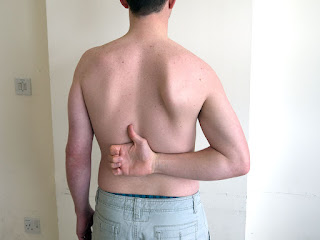 |
| Ref: https://jackhanrahanfitness.com/ |
Anatomically, Latissimus dorsi is a large flat muscle attached between the half lower spine and shoulder. It plays a vital role in pathomechanics of mechanical low back pain. Including shoulder pain, upper back pain, and maybe neck pain because it can make scapular motion changes or scapular dyskinesis.
 |
| Ref: https://www.quora.com/ |
In my physiotherapy experience, weakness and stiffness of latissimus dorsi develops poor posture. For example, I have named The Gorilla posture which I have seen in muscular men because of the stiffness of this muscle, moreover, I have called it as The swimmers posture which I have seen in swimmers athletes. It frequently causes shoulder pain in this posture. According to some reports, they mentioned to canoeists and rugby players that I never treated them.
 |
| Ref: https://www.dreamstime.com/ |
Occasionally, I took care of a neck pain patient with breast augmentation. They had neck pain, upper back pain, or shoulder pain that could trick me to treat other muscles i.e. rotator cuff. The involved soft tissue of breast augmentation may result from incision scar and myofascial fascia stiffness and latissimus dorsi stiffness.
Therefore, latissimus dorsi stretching is necessary for shoulder pain and back pain.
3 poses option to stretch latissimus dorsi
Exercise #1: Stand latissimus dorsi stretch: to bend the torso to the opposite side of the target muscle that needs to place the hand on the wall for balancing and place the same foot behind the non - target side. Shift body weight to the hip which has the same target muscle side.
Exercise #2: Child pose lateral bending: start with child pose and bend the torso to the opposite side of target muscle.
Exercise #3: Gym ball latissimus dorsi stretch: this is floor exercise with the gym ball. Put non - target muscle on the ball, then place both feet anywhere which is the most stable. Elevate arm with close to the ear.
The latissimus dorsi is primarily considered a muscle with actions at the shoulder, despite its widespread attachments at the spine. There is some dispute regarding the potential contribution of this muscle to lumbar spine function.
Latissimus dorsi is a unique muscle in terms of its anatomical design. It is a relatively thin, fan-shaped muscle, and is one of the largest in the body in surface area. It covers a significant portion of the back to shoulder that there is some dispute regarding the potential contribution of this muscle to lumbar spine and shoulder function.
 |
| Latissimus dorsi muscle (Bright red) (Ref: https://www.physio-pedia.com/) |
Its attachments from the spinous processes of the lower six thoracic vertebrae, lumbar vertebrae, and sacrum, as well as to the ilium via the thoracolumbar fascia. Muscle fibers then converge superiolaterally toward the axilla via inferior 3 or 4 ribs and inferior angle of scapula , where the fibers converge to a single twisted tendon that is inserted in the intertubercular groove of the humerus which is onto the anterior aspect of the proximal humerus.
 |
| Insertion of latissimus dorsi (Ref: https://www.medicinebau.com/) |
Muscle function of latissimus dorsi includes shoulder adducts, shoulder extends and shoulder internal rotates that are hand behind back. It provides a powerful rotator of the trunk and assist back extension. It is the antagonist of deltoid and trapezius muscle. The structural characteristics of this muscle are those of a global mobiliser. The muscle will therefore shorten, this will cause limited glenohumeral joint flexion and external rotation.
 |
| Hand behind back (Ref: https://www.medistudents.com/) |
The latissimus dorsi plays an important role in basic back activities such as trunk extension and rotation. There is a prevalence rate of 73% for latissimus dorsi tightness in active mechanical low back pain patients. A decrease in length or increase in stiffness of latissimus dorsi can lead to alterations in movement patterns and postures which cause exacerbation of low back pain that is a pathomechanics low back pain. A decrease in length or an increase in stiffness of this muscle can lead to alterations in movement patterns and/or postures which can cause an increase in low back pain. Latissimus dorsi in association with thoracolumbar fascia helps in force distribution that the posterior layer of thoracolumbar fascia which is formed through latissimus dorsi can effectively contribute to low back pain.
 |
| Latissimus dorsi length test: normal length (left), stiffness (right) (Ref: https://www.mitchmedical.us/) |
The length of latissimus dorsi can be assessed by means of a reliable test to maintain treatment efficacy and objectivity. An latissimus dorsi length test explained by McConnell (1994) described a patient in crook lying. The patient has to decrease the lumbar lordosis actively by controlling the anterior pelvic tilt (by actively keeping the back flat) to do flexion with the glenohumeral joint in a neutral position with no glenohumeral rotation being allowed. The range of motion of glenohumeral joint flexion is measured using a goniometer at the point when the patient’s lumbar spine starts tilting anteriorly and lifts off the plinth, or when the glenohumeral starts to internally rotate.
Discussion from above, to reverse muscle function for stretching this muscle should illustrate torso rotation and shoulder abduction. VIDEOs did not demonstrate torso rotation and shoulder abduction, however, torso lateral bending and shoulder adduction in flexion. Other motions are the same as above including shoulder flexion, shoulder external rotation, and lower back flexion.
 |
| Ref: https://www.enjoy-swimming.com/ |
The principle to stretch this muscle is the same as the others: stretch to the point where “tightness with pain” or “noticeable tension without pain” will hold at the point for 30 seconds of 3 - 5 reputations following demonstrated VIDEO.
Reference:
https://www.scielo.cl/pdf/ijmorphol/v24n4/art30.pdf
https://onlinelibrary.wiley.com/doi/full/10.1111/joa.12074
https://www.sciencedirect.com/science/article/pii/S2095254613000215
https://www.ijsr.net/archive/v9i8/SR20730124217.pdf




ไม่มีความคิดเห็น:
แสดงความคิดเห็น